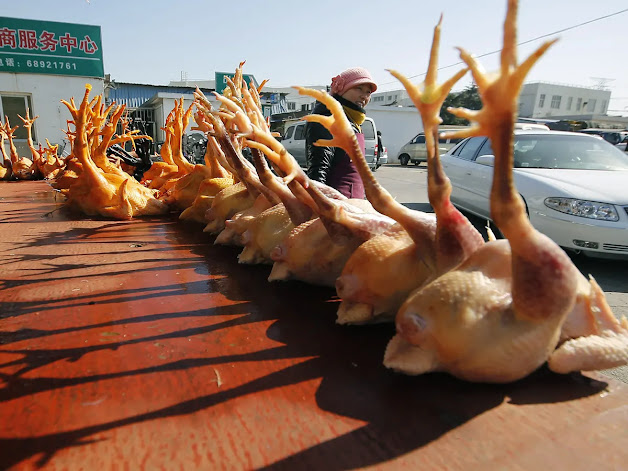China reports first human case of H10N3 bird flu
A 41-year-old man in China’s eastern province of Jiangsu has been confirmed as the first human case of infection with a rare strain of bird flu known as H10N3, Beijing’s National Health Commission (NHC) has said.
Many different strains of bird flu are present in China and some occasionally infect people, usually those working with poultry. There is no indication that H10N3 can spread easily in humans.
The man, a resident of the city of Zhenjiang, was admitted to hospital on April 28 and diagnosed with H10N3 on May 28, the health commission said on Tuesday. It did not give details on how the man was infected.
His condition is now stable and he is ready to be discharged. Investigation of his close contacts found no other cases, the NHC said.
No other cases of human infection with H10N3 have been reported globally, it added.
H10N3 is low pathogenic, which means it causes relatively less severe disease in poultry and is unlikely to cause a large-scale outbreak, the NHC added.
Patient’s exposure ‘unknown’
The World Health Organization (WHO), in a reply to the Reuters news agency in Geneva, said: “The source of the patient’s exposure to the H10N3 virus is not known at this time and no other cases were found in emergency surveillance among the local population. At this time, there is no indication of human-to-human transmission.
“As long as avian influenza viruses circulate in poultry, sporadic infection of avian influenza in humans is not surprising, which is a vivid reminder that the threat of an influenza pandemic is persistent,” the WHO added.
The strain is “not a very common virus”, said Filip Claes, the regional laboratory coordinator of the Food and Agriculture Organization (FAO) Emergency Centre for Transboundary Animal Diseases at the regional office for Asia and the Pacific.
Only about 160 isolates of the virus were reported in the 40 years to 2018, mostly in wild birds or waterfowl in Asia and some limited parts of North America, and none had been detected in chickens so far, he added.
Analysing the genetic data of the virus will be necessary to determine whether it resembles older viruses or if it is a novel mix of different viruses, Claes said.
The last human epidemic of bird flu in China occurred in late 2016 and continued until 2017 with the H7N9 virus.
H7N9 has infected 1,668 people and killed 616 since 2013, according to the UN’s FAO.
Following recent avian flu outbreaks in Africa and Eurasia, the head of China’s Centre for Disease Control and Prevention last week urged stricter surveillance in poultry farms, markets and wild birds.
Many different strains of bird flu are present in China and some occasionally infect people, usually those working with poultry. There is no indication that H10N3 can spread easily in humans.
The man, a resident of the city of Zhenjiang, was admitted to hospital on April 28 and diagnosed with H10N3 on May 28, the health commission said on Tuesday. It did not give details on how the man was infected.
His condition is now stable and he is ready to be discharged. Investigation of his close contacts found no other cases, the NHC said.
No other cases of human infection with H10N3 have been reported globally, it added.
H10N3 is low pathogenic, which means it causes relatively less severe disease in poultry and is unlikely to cause a large-scale outbreak, the NHC added.
Patient’s exposure ‘unknown’
The World Health Organization (WHO), in a reply to the Reuters news agency in Geneva, said: “The source of the patient’s exposure to the H10N3 virus is not known at this time and no other cases were found in emergency surveillance among the local population. At this time, there is no indication of human-to-human transmission.
“As long as avian influenza viruses circulate in poultry, sporadic infection of avian influenza in humans is not surprising, which is a vivid reminder that the threat of an influenza pandemic is persistent,” the WHO added.
The strain is “not a very common virus”, said Filip Claes, the regional laboratory coordinator of the Food and Agriculture Organization (FAO) Emergency Centre for Transboundary Animal Diseases at the regional office for Asia and the Pacific.
Only about 160 isolates of the virus were reported in the 40 years to 2018, mostly in wild birds or waterfowl in Asia and some limited parts of North America, and none had been detected in chickens so far, he added.
Analysing the genetic data of the virus will be necessary to determine whether it resembles older viruses or if it is a novel mix of different viruses, Claes said.
The last human epidemic of bird flu in China occurred in late 2016 and continued until 2017 with the H7N9 virus.
H7N9 has infected 1,668 people and killed 616 since 2013, according to the UN’s FAO.
Following recent avian flu outbreaks in Africa and Eurasia, the head of China’s Centre for Disease Control and Prevention last week urged stricter surveillance in poultry farms, markets and wild birds.




Comments
Post a Comment